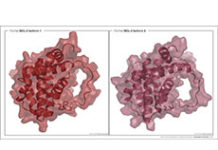Patients with unresectable and/or metastatic melanoma achieved high rates of durable response following treatment with a triplet regimen of PD-1 inhibitor, spartalizumab in combination with the BRAF inhibitor, dabrafenib and the MEK inhibitor, trametinib. Findings from the efficacy, safety, and biomarker analysis of parts 1 and 2 of the randomised, placebo-controlled phase III COMBI-i trial (NCT02967692) were reported in the Nature Medicine on 5 October 2020.
Reinhard Dummer, Professor at the University of Zurich and Vice-Chairman of the Department of Dermatology in the University Hospital of Zürich, Switzerland and colleagues conducted this analysis of COMBI-i data.
All 36 patients with previously untreated BRAF V600-mutant unresectable or metastatic melanoma were treated with 400 mg of spartalizumab every 4 weeks plus 150 mg of dabrafenib twice daily and 2 mg of trametinib once daily. Part 2 of this trial was a biomarker analysis that characterised changes in PD-L1 levels and CD8+ cells following treatment as the primary endpoint, and investigated additional biomarkers; efficacy per RECIST and safety were key secondary endpoints.
The triplet regimen led to durable responses
With median follow-up of 24.3 months, the spartalizumab, dabrafenib, and trametinib regimen provided a 78% confirmed objective response rate (ORR; 95% confidence interval [CI] 61–90) consisting of 44% complete response (CR) and 33% partial response (PR). In addition, 17% of patients showed stable disease, just 3% of patients experienced progressive disease (PD), and 3% had unknown outcome, leading to a 95% disease control rate (DCR; CR+PR+SD). In responding patients, the median duration of response (DoR) was not estimable (NE; 95% CI 17 months-NE). The 12- and 24-month rates were 80% and 53%, respectively.
Regarding survival, the median progression-free survival (PFS) was 23 months (95% CI 12-NE), with 12- and 24- month rates of 67% and 41%, respectively. Median overall survival (OS) was NE (95% CI NE-NE) and the respective OS rates at 12- and 24-months were 86% and 74%.
A subgroup of 15 patients with an LDH level ≥1× the upper limit of normal at baseline demonstrated a confirmed ORR of 67%, comprising 27% CR, 40% PR, 20% SD, 7% PD, and 7% unknown. The DCR was 87%, and median DoR was NE (95% CI 4-NE), with 12- and 21-month rates of 65% and 52%, respectively. In this cohort, median PFS was 11 (95% CI 5–19) months, and the estimated 24-month PFS rate was 27%. Median OS was NE with an estimated 24-month OS rate of 53% (95% CI 25–74%).
The patients had a median exposure to the regimen of 13.4 (range, 2.5–29.4) months. All of the patients had at least one adverse event (AE), with 81% experiencing at least one grade ≥3 AE. Treatment-related AEs (TRAEs) were observed in all patients; of these 72% were grade ≥3 and included pyrexia (17%), increased lipase (11%), and neutropenia (11%).
All patients had temporary dose modifications due to AEs; of these, most were reversible with the exception of 17% of patients who permanently discontinued all 3 study drugs.
Complete response associated with low baseline ctDNA levels
The biomarker analysis included RNA sequencing (RNA-seq) and target DNA sequencing of tissue samples from patients with >12 months of follow-up. This analysis showed an association between early PFS events and low tumour mutational burden (TMB)/T cell–inflamed gene expression signature (GES) levels, high levels of specific immunosuppressive TME signatures, and elevated baseline levels of circulating tumour DNA.
An evaluation of biomarker profiles in samples from patients achieving CR compared with the profiles of all other patients revealed an association between CR and low or no detectable baseline ctDNA levels. CR did not associated with known markers for immunotherapy response such as TMB and T cell–inflamed GES but did associate with tumours having lower baseline levels of immunosuppressive TME signatures.
Biomarker modulations following treatment were assessed by tissue immunohistochemistry, RNA-seq, and comparison of plasma IFN-γ levels between baseline and on-treatment samples. Unpaired comparisons among different time-points showed upregulation of PD-L1; at baseline, 68% of patients had a PD-L1-positive tumour, whereas 91% of patients with available PD-L1 results had a PD-L1-positive tumour after 2–3 weeks of treatment. Additionally, 25 of 27 (93%) patients had elevated plasma IFN-γ levels following 4 weeks of treatment. Furthermore, an increase in T cell–specific GESs was observed by RNA-seq when paired baseline and 2- to 3-week on-treatment biopsies were compared. Furthermore, cell cycle GESs were decreased from baseline levels to the time of biopsy taken at 2–3 weeks.
Conclusions
According to the authors, the 24-month OS rate of 74% observed with spartalizumab, dabrafenib, and trametinib compares favourably with OS rates from phase III trials of either dabrafenib plus trametinib or anti-PD-1 therapy.
They noted that it will be important to track the change in benefits over time with this regimen and pointed out that the ongoing randomised, placebo-controlled, phase III portion of COMBI-i will further clarify the potential of spartalizumab plus dabrafenib and trametinib in patients with BRAF V600-mutant metastatic melanoma.
Funding for COMBI-i was reported from Novartis.
Reference
Dummer R, Lebbé C, Atkinson V, et al. Combined PD-1, BRAF and MEK inhibition in advanced BRAF-mutant melanoma: safety run-in and biomarker cohorts of COMBI-i. Nature Medicine, 2020;26:1557–1563. DOI: https://doi.org/10.1038/s41591-020-1082-2.








